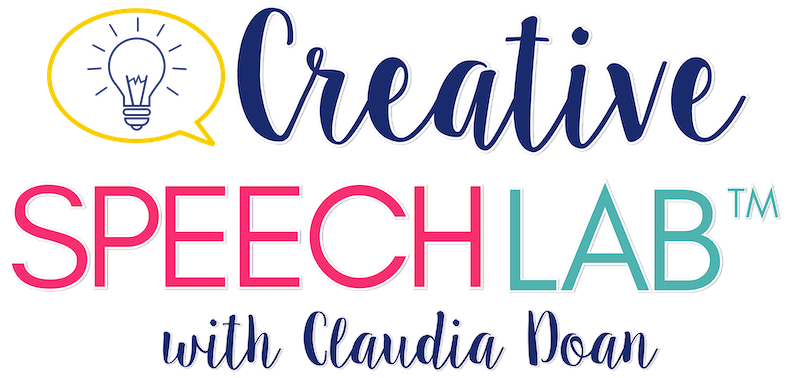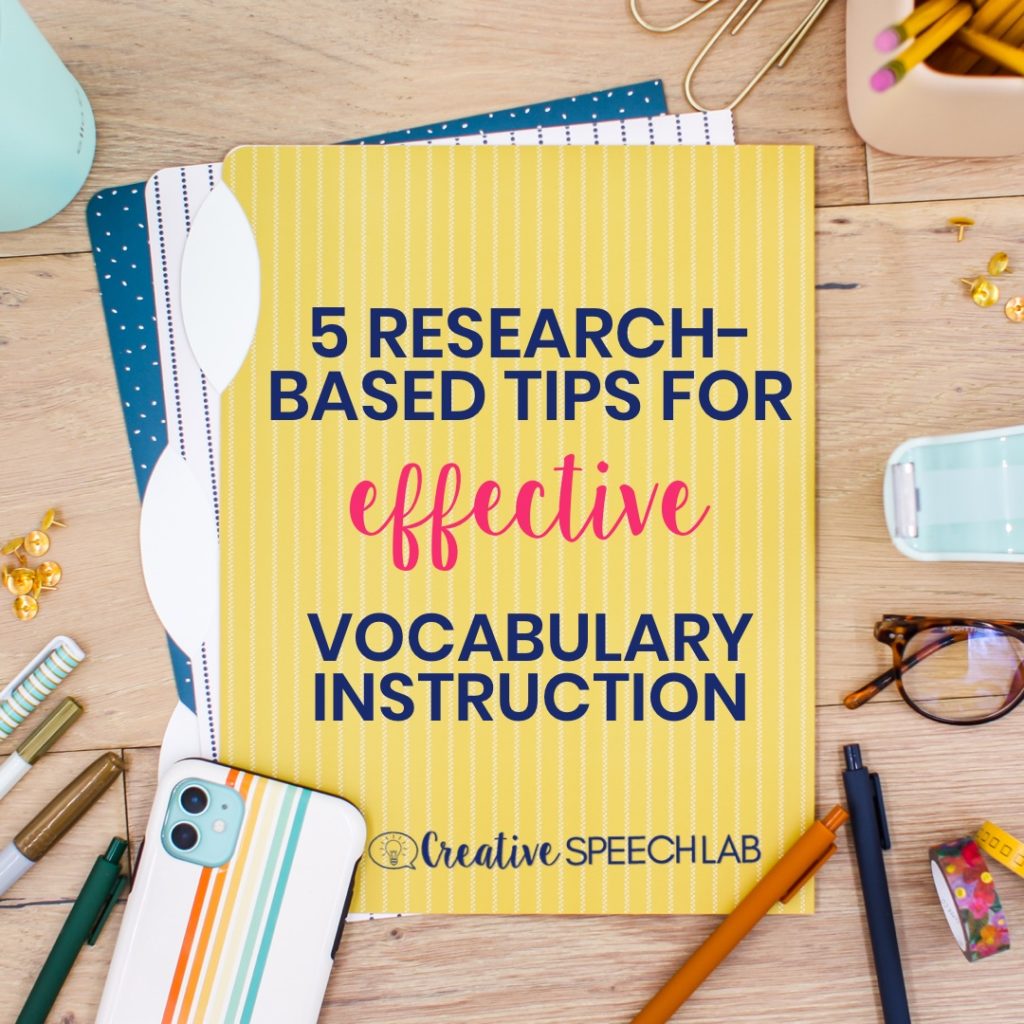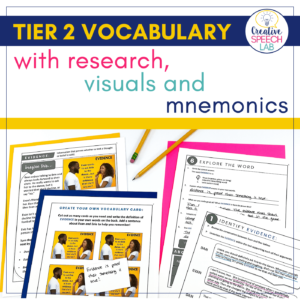Vocabulary knowledge affects virtually all aspects of learning. It lays the groundwork for the comprehension of academic concepts across subject areas and builds strong readers.
What does the research have to say about effective vocabulary instruction? I read through a huge number of articles as I created my Tier 2 Vocabulary Intervention with Research, Visuals & Mnemonics.
Here are 5 key takeaways you can implement in your instruction today!
1. Use a phonological-semantic approach
What does this mean exactly? Essentially, a phonological-semantic approach includes a discussion of the phonological features of the target word (i.e. number of syllables, rhyming words, initial and final sounds). In conjunction, the semantic approach delves into the meaning of the word. Researchers have surmised that incorporating a phonological component alongside semantic instruction is effective for children and adolescents with language disorders because they commonly experience difficulty with the phonological processing needed for naming words.
(Lowe et al., 2017)
2. Provide 8-20 exposures of the vocabulary word in spoken and written contexts
Perhaps not surprisingly, multiple repetitions of target words in context is an important component to effective vocabulary instruction. Researchers aptly described how the process of acquiring a word is often gradual in nature. In addition, as children get older, they increasingly rely on text for exposure to new vocabulary, which is why research supports the use of both presentations.
(Elleman et al., 2019; Frishkoff et al., 2011; Horst et al., 1998; Waring & Takaki, 1984; Haynes & Ahrens, 1988; Montag et al., 2015)
3. Use Tier 2 Vocabulary
If you know me, you know I’m a huge proponent of Tier 2 Vocabulary, which consists of high-frequency words that occur across the curriculum (e.g. evaluate, infer). Why Tier 2? Researchers describe this subset of vocabulary as having “high utility because they are useful across multiple contexts” (Elleman et al., 2019).
4. Form a semantic web
As you know, vocabulary words are not learned in isolation. Rather, each word is inextricably linked to other words. With this in mind, research supports the examination of how target words relate to other vocabulary through the use of graphic organizers and group discussions. Specifically, the creation of word webs and a discussion of synonyms and antonyms can help form a well-rounded semantic network.
In addition, the use of morphological analysis (i.e. breaking the word down into root words and affixes) can be a helpful tool in exploring word relationships and meanings.
(Elleman et al., 2019)
5. Incorporate active processing vs. passive learning activities
Passive learning activities (e.g. copying word definitions) were found to be less effective than active processing activities in which students actively engaged in discussion, meaningful experiences and written expression related to target words.
(Elleman et al., 2019; Stahl & Fairbanks, 1986; Wright & Cervetti, 2016; Ford-Connors & Paratore, 2015; McKeown et al., 2018; Elleman et al., 2009; Murphy et al., 2009)
I actually summarized all of this information on this handy printable, which is a part of my Tier 2 Vocabulary Intervention with Research, Visuals & Mnemonics resource!
I’m a big-believer in the importance of evidence-based practice in speech-language therapy, which is why I’ve incorporated all of this research into my Tier 2 Vocabulary Intervention with Research, Visuals & Mnemonics.
Try a FREE SAMPLE in my Freebie Library (below the references).
References:
Elleman, A.M., Lindo, E.J., Morphy, P., & Compton, D.L. (2009). The impact of vocabulary instruction on passage-level comprehension of school-age children: A meta-analysis. Journal of Research on Educational Effectiveness, 2(1), 1-44.
Elleman, A. M., Oslund, E. L., Griffin, N. M., & Myers, K. E. (2019). A Review of Middle School Vocabulary Interventions: Five Research-Based Recommendations for Practice. Language, Speech, and Hearing Services in Schools, 50(4), 477–492. https://doi.org/10.1044/2019_lshss-voia-18-0145
Ford-Connors, E., & Paratore, J.R. (2015). Vocabulary instruction in fifth grade and beyond: Sources of word learning and productive contexts for development. Review of Educational Research, 85(1), 50-91.
Frishkoff, G.A., Perfetti, C.A., & Collins-Thompson, K. (2011). Predicting robust vocabulary growth form measures of incremental learning. Scientific Studies of reading, 15(1), 71-91.
Haynes, D.P., & Ahrens, M.G. (1988). Vocabulary simplification for children: A special case of “Motherese”. Journal of Child Language, 15(2), 395-410.
Horst, M., Cobb, T., & Meara, P. (1998). Beyond a clockwork orange: Acquiring second language vocabulary through reading. Reading in a Foreign Language, 11(2), 207-233.
Lowe, H., Henry, L., Müller, L., & Joffe, V. L. (2017). Vocabulary intervention for adolescents with language disorder: a systematic review. International Journal of Language & Communication Disorders, 53(2), 199–217. https://doi.org/10.1111/1460-6984.12355
McKeown, M.G., Crosson, A.C., Moore, D.W., & Beck, I.L (2018). Word knowledge and comprehension effects of an academic vocabulary intervention for middle school students. American Educational Research Journal, 55(3), 572-616.
Montag, J.L., Jones, M.N., & Smith, L.B. (2015). The words children hear: Picture books and the statistics for language learning. Psychological Science, 26(9), 1489-1496.
Murphy, P.K., Wilkinson, I.A., Soter, A.O., Hennessey, M.N. & Alexander, J.F. (2009). Examining the effects of classroom discussion on students’ comprehension of text: A meta-analysis. Journal of Educational Psychology, 101(3), 740-764.
Stahl, S.A., & Fairbanks, M.M. (1986). The effects of vocabulary instruction: A model-based meta-analysis. Review of Educational Research, 56(1), 72-110.
Waring, R., & Takaki, M. (2003). At what rate do learners learn and retain new vocabulary from reading a graded reader. Reading in a Foreign Language, 15(2), 130-163.
Wright, T.S., & Cervetti, G.N. (2016). A systematic review of the research on vocabulary instruction that impacts text comprehension. Reading Research Quarterly, 52(2), 203-226.








4 Comments
These are great! Thank you!
You’re very welcome! I’m so glad to hear that!
Creative and innovative ideas
Thanks 😊
You’re very welcome! So glad you’re finding them helpful!